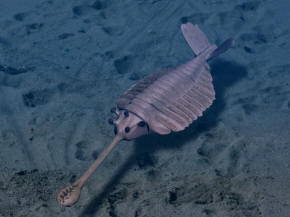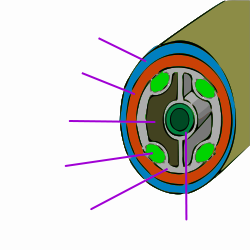The Cambrian explosion has generated extensive scientific debate. The seemingly rapid appearance of fossils in the “Primordial Strata” was noted as early as the mid 19th century, and Charles Darwin saw it as one of the main objections that could be made against his theory of evolution by natural selection.
The long-running puzzlement about the appearance of the Cambrian fauna, seemingly abruptly and from nowhere, centers on three key points: whether there really was a mass diversification of complex organisms over a relatively short period of time during the early Cambrian; what might have caused such rapid change; and what it would imply about the origin and evolution of animals. Interpretation is difficult due to a limited supply of evidence, based mainly on an incomplete fossil record and chemical signatures left in Cambrian rocks.
History and significance
Geologists as long ago as Buckland (1784–1856) realised that a dramatic step-change in the fossil record occurred around the base of what we now call the Cambrian. Charles Darwin considered this sudden appearance of many animal groups with few or no antecedents to be the greatest single objection to his theory of evolution. He had even devoted a substantial chapter of The Origin of Species to solving this problem.
American palæontologist Charles Walcott proposed that an interval of time, the “Lipalian”, was not represented in the fossil record or did not preserve fossils, and that the ancestors of the Cambrian animals evolved during this time.
More recently it was discovered that the history of life on earth goes back at least 3,450 million years: rocks of that age at Warrawoona in Australia contain fossils of stromatolites, stubby pillars that are formed by colonies of micro-organisms. Fossils (Grypania) of more complex eukaryotic cells, from which all animals, plants and fungi are built, have been found in rocks from 1,400 million years ago, in China and Montana. Rocks dating from 565 to 543 million years ago contain fossils of the Ediacara biota, organisms so large that they must have been multi-celled, but very unlike any modern organism. P. E. Cloud argued in 1948 that there was a period of "eruptive" evolution in the Early Cambrian, but as recently as the 1970s there was no sign of how the relatively modern-looking organisms of the Middle and Late Cambrian arose.
The intense modern interest in this "Cambrian explosion" was sparked by the work of Harry B. Whittington and colleagues, who in the 1970s re-analysed many fossils from the
 |
| Opabinia made the largest single contribution to modern interest in the Cambrian explosion. (Picture Source) |
But other analyses, some more recent and some dating back to the 1970s, argue that complex animals similar to modern types evolved well before the start of the Cambrian. There has also been intense debate whether there was a genuine "explosion" of modern forms in the Cambrian and, to the extent that there was, how it happened and why it happened then.
Types of Evidence
Deducing the events of half a billion years ago is difficult, as evidence comes exclusively from biological and chemical signatures in rocks and very sparse fossils.
Dating the Cambrian
Accurate absolute radiometric dates for much of the Cambrian, obtained by detailed analysis of radioactive elements contained within rocks, have only rather recently become available, and for only a few regions.
Relative dating (A was before B) is often sufficient for studying processes of evolution, but this too has been difficult, because of the problems involved in matching up rocks of the same age across different continents.
Therefore dates or descriptions of sequences of events should be regarded with some caution until better data become available.
Body Fossils
Fossils of organisms' bodies are usually the most informative type of evidence. Fossilisation is a rare event, and most fossils are destroyed by erosion or metamorphism before they can be observed. Hence the fossil record is very incomplete, increasingly so, further back in time. Despite this, they are often adequate to illustrate the broader patterns of life's history. There are also biases in the fossil record: different environments are more favourable to the preservation of different types of organism or parts of organisms. Further, only the parts of organisms that were already mineralised are usually preserved, such as the shells of molluscs. Since most animal species are soft-bodied, they decay before they can become fossilised. As a result, although there are 30-plus phyla of living animals, two-thirds have never been found as fossils.
The Cambrian fossil record includes an unusually high number of lagerstätten, which preserve soft tissues. These allow palæontologists to examine the internal anatomy of animals which in other sediments are only represented by shells, spines, claws, etc – if they are preserved at all. The most significant Cambrian lagerstätten are the early Cambrian Maotianshan shale beds of Chengjiang (Yunnan, China) and Sirius Passet (Greenland); the middle Cambrian Burgess Shale (British Columbia, Canada); and the late Cambrian Orsten (Sweden) fossil beds.
While lagerstätten preserve far more than the conventional fossil record, they are far from complete. Because lagerstätten are restricted to a narrow range of environments (where soft-bodied organisms can be preserved very quickly, e.g. by mudslides), most animals are probably not represented; further, the exceptional conditions that create lagerstätten probably do not represent normal living conditions. In addition, the known Cambrian lagerstätten are rare and difficult to date, while Precambrian lagerstätten have yet to be studied in detail.
The sparseness of the fossil record means that organisms usually exist long before they are found in the fossil record – this is known as the Signor-Lipps effect.
Trace Fossils
Trace fossils consist mainly of tracks and burrows, but also include coprolites (fossil feces) and marks left by feeding. Trace fossils are particularly significant because they represent a data source that is not limited to animals with easily-fossilized hard parts, and which reflects organisms' behaviour. Also many traces date from significantly earlier than the body fossils of animals that are thought to have been capable of making them. Whilst exact assignment of trace fossils to their makers is generally impossible, traces may for example provide the earliest physical evidence of the appearance of moderately complex animals (comparable to earthworms).
Geochemical Observations
Several chemical markers indicate a drastic change in the environment around the start of the Cambrian. The markers are consistent with a mass extinction, or with a massive warming resulting from the release of methane ice. Such changes may reflect a cause of the Cambrian explosion, although they may also have resulted from an increased level of biological activity – a possible result of the explosion. Despite these uncertainties, the geochemical evidence helps by making scientists focus on theories that are consistent with at least one of the likely environmental changes.
Phylogenetic techniques
Cladistics is a technique for working out the “family tree” of a set of organisms. It works by the logic that, if groups B and C have more similarities to each other than either has to group A, then B and C are more closely related to each other than either is to A. Characteristics which are compared may be anatomical, such as the presence of a notochord, or molecular, by comparing sequences of DNA or protein. The result of a successful analysis is a hierarchy of clades – groups whose members are believed to share a common ancestor. The cladistic technique is sometimes fallible, as some features, such as wings or camera eyes, evolved more than once, convergently – this must be taken into account in analyses.
From the relationships, it may be possible to constrain the date that lineages first appeared. For instance, if fossils of B or C date to X million years ago and the calculated "family tree" says A was an ancestor of B and C, then A must have evolved more than X million years ago.
It is also possible to estimate how long ago two living clades diverged – i.e. approximately how long ago their last common ancestor must have lived – by assuming that DNA mutations accumulate at a constant rate. These "molecular clocks", however, are fallible, and provide only a very approximate timing: they are not sufficiently precise and reliable for estimating when the groups that feature in the Cambrian explosion first evolved, and estimates produced by different techniques vary by a factor of two. However, the clocks can give an indication of branching rate, and when combined with the constraints of the fossil record, recent clocks suggest a sustained period of diversification through the Ediacaran and Cambrian.
Explanation of a few scientific terms
A phylum is the highest level in the Linnean system for classifying organisms. Phyla can be thought of as groupings of animals based on general body plan. Despite the seemingly different external appearances of organisms, they are classified into phyla based on their internal and developmental organizations. For example, despite their obvious differences, spiders and barnacles both belong to the phylum Arthropoda; but earthworms and tapeworms, although similar in shape, belong to different phyla.
A phylum is not a fundamental division of nature, such as the difference between electrons and protons. It is simply a very high-level grouping in a classification system created to describe all currently living organisms. This system is imperfect, even for modern animals: different books quote different numbers of phyla, mainly because they disagree about the classification of a huge number of worm-like species. As it is based on living organisms, it accommodates extinct organisms poorly, if at all.
The concept of stem groups was introduced to cover evolutionary "aunts" and "cousins" of living groups. A crown group is a group of closely-related living animals plus their last common ancestor plus all its descendants. A stem group is a set of offshoots from the lineage at a point earlier than the last common ancestor of the crown group; it is a relative concept, for example tardigrades are living animals which form a crown group in their own right, but Budd (1996) regarded them also as being a stem group relative to the arthropods.
Triploblastic means consisting of 3 layers, which are formed in the embryo, quite early in the animal's development from a single-celled egg to a larva or juvenile form. The innermost layer forms the digestive tract (gut); the outermost forms skin; and the middle one forms muscles and all the internal organs except the digestive system. Most types of living animal are triploblastic – the best-known exceptions are Porifera (sponges) and Cnidaria (jellyfish, sea anemones, etc.).
The bilaterians are animals which have right and left sides at some point in their life history. This implies that they have top and bottom surfaces and, importantly, distinct front and back ends. All known bilaterian animals are triploblastic, and all known triploblastic animals are bilaterian. Living Echinoderms (sea stars, sea urchins, sea cucumbers, etc.) look radially symmetrical (like wheels) rather than bilaterian, but their larvae exhibit bilateral symmetry and some of the earliest echinoderms may have been bilaterally symmetrical. Porifera and Cnidaria are radially symmetrical, non-bilaterian and non-triploblastic.
Coelomate means having a body cavity (coelom) which contains the internal organs. Most of the phyla featured in the debate about the Cambrian explosion are coelomates: arthropods, annelid worms, molluscs, echinoderms and chordates – the non-coelomate priapulids are an important exception. All known coelomate animals are triploblastic bilaterians, but some triploblastic bilaterian animals do not have a coelom – for example flatworms, whose organs are surrounded by unspecialized tissues.
![]()
Return to the Old Earth Ministries Online Earth History Curriculum homepage.
![]()
Source: Cambrian Explosion
